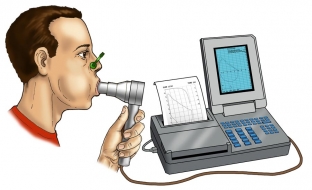Bronchial asthma – This is a serious chronic disease of the respiratory system, which significantly affects the patient's quality of life. The longer and more difficult the pathology proceeds, the higher the likelihood of its transition to the next degree of severity, as well as the likelihood of complications. That is why early diagnosis of bronchial asthma plays a very important role for further prediction of the course of the disease. Since symptoms of asthma, such as cough and shortness of breath, can occur with many other pathologies, it is very important to ask the patient the right questions, which greatly facilitate the diagnostic process of bronchial asthma.
Laboratory and instrumental methods for diagnosing bronchial asthma
Diagnosis of bronchial asthma is a rather complicated process, which is based primarily on anamnestic data and the results of an objective examination. With the help of correctly collected information, it is possible not only to confirm the presumptive diagnosis of bronchial asthma, but also to choose the right treatment regimen suitable for a particular patient. Instrumental and laboratory methods that are used to diagnose bronchial asthma make it possible to clarify the nature of the lesion and the severity of the pathology. Knowledge of the main diagnostic criteria for bronchial asthma greatly facilitates the process of making a diagnosis.
Diagnosis of bronchial asthma:
- what questions should be asked to the patient in the process of diagnosing bronchial asthma;
- laboratory and instrumental methods for diagnosing bronchial asthma;
- The main criteria for the diagnosis of bronchial asthma.
What questions should be asked to the patient in the process of diagnosing bronchial asthma
The literacy of the doctor and his ability to ask the right questions greatly facilitates the diagnostic process of any disease. What questions should be asked to the patient if bronchial asthma is suspected:
- Does the patient have bouts of wheezing?
- Does the patient have bouts of severe, agonizing coughing in the evening?
- Do coughing and wheezing occur after exercise?
- Does exposure to airborne allergens cause a patient to experience the above symptoms?
- Does the patient often have rhinitis or pharyngitis complicated by bronchitis, or does it last more than 10 days?
- Does anti-asthma therapy help alleviate these symptoms?
Yes answers to all these questions are highly likely to indicate that the patient has bronchial asthma.
Laboratory and instrumental methods for diagnosing bronchial asthma
Additional research methods greatly help in the diagnosis of bronchial asthma. First of all, it is necessary to examine the function of the external respiration of the patient. According to the results of spirometry, a decrease in FEV1 and PSV indicates the presence of bronchial obstruction, and an increase in FEV1 after the use of bronchodilators indicates a reverse bronchospasm, which is typical for bronchial asthma. Determination of a high level of eosinophils, Kurshman's spirals and Charcot-Leiden crystals in bronchial secretion also indicates bronchial asthma. It is important to examine the levels of immunoglobulins in the patient's blood. Conducting functional tests with bronchodilators helps to establish the reversibility of broncho-obstructive syndrome, which is important for determining the severity of bronchial asthma.

Basic criteria for diagnosing asthma
Today, there are clear clinical, anamnestic and instrumental criteria for diagnosing bronchial asthma.
Clinical and anamnestic criteria:
- the presence of attacks of shortness of breath, coughing and wheezing;
- presence of bronchial asthma in the patient's relatives;
- worse allergic history.
Instrument criteria:
- reversible obstructive respiratory dysfunction;
- high level of eosinophils in the blood;
- presence of eosinophils, Kurschmann spirals and Charcot-Leiden crystals in the patient's sputum.
Knowing all these criteria and comparing them with the patient's data greatly facilitates the diagnostic process of bronchial asthma.







Add a comment